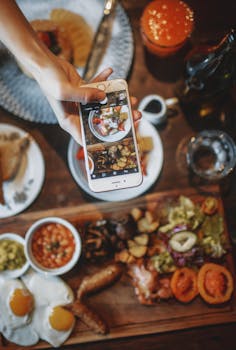Annonces
Food is more than just sustenance; it’s a medium through which cultures express themselves, stories are told, and communities come alive. The importance of content in the realm of food cannot be overstated, as it shapes our understanding of cuisines, traditions, and culinary experiences.
The way food is presented, discussed, and celebrated in our daily lives greatly impacts its appeal and accessibility. From the vibrant visuals that flood social media feeds to the rich narratives that accompany recipes, content plays a vital role in transforming food into an experience.
Moreover, with the advent of digital platforms, the manner in which we consume and interact with food content has evolved significantly. This article delves into the multifaceted role that content performs in the culinary landscape, focusing on how it influences perception, inspires creativity, and fosters connections among individuals and communities.
The Importance of Visual Content in Food
Visual content serves as the first point of interaction with food. In today’s digital age, stunning imagery can captivate potential diners and home cooks. High-quality photos can inspire creativity in the kitchen and drive engagement.
Platforms like Instagram and Pinterest thrive on food photography, where appealing images can lead to viral trends. The old saying “we eat with our eyes first” holds true as beautifully presented dishes often lead to greater interest and appetite.
Annonces
Moreover, visual content helps convey emotions and stories behind dishes. Through compelling imagery, viewers can connect with the culture and history behind the food, creating a richer understanding and appreciation.
Additionally, videos showcasing cooking processes are immensely popular. They enable viewers to visualize techniques and ingredients, making recipes more accessible and enjoyable.
In summary, visual content is integral to food’s allure, serving as a powerful storytelling tool that enhances both understanding and enjoyment of culinary experiences.
Annonces
Written Content and Its Impact
Written content, such as blogs, articles, and cookbooks, provides depth and context to food-related topics. It allows writers to share their experiences, knowledge, and cultural backgrounds, enriching the reader’s understanding.
Accessibility is another critical component. Recipes, once limited to family traditions, are now shared worldwide, thanks to online platforms. This democratization of information fosters diversity in culinary practices.
Furthermore, written content often incorporates personal anecdotes, making it relatable and engaging. Readers often seek out narratives that resonate with their own experiences, creating a community through shared stories.
Recipes enhanced with background information on origins not only educate readers but also provide insights into regional variations. This knowledge fosters appreciation for diverse culinary practices.
Ultimately, written content plays a crucial role in food culture, supporting the exploration of new cuisines while linking people through shared experiences and stories related to food.
Social Media and the Food Experience
Social media platforms have revolutionized the way we share and experience food. Users now curate their culinary adventures, showcasing everything from simple home-cooked meals to extravagant dining experiences.
This sharing culture encourages others to explore new dishes and culinary trends. Food-related hashtags enable users to discover inspiration and connect with food enthusiasts worldwide.
Moreover, influencers and chefs utilize social media to engage their audiences, building a relationship through shared passions. Their personal branding allows followers to feel connected to their culinary journeys.
User-generated content also plays a vital role, as diners share their experiences through reviews and photos. This feedback can significantly impact restaurant success, shaping perceptions and driving business.
Overall, social media has transformed food from a personal experience into a shared phenomena, fostering community and inspiration around culinary exploration.
The Role of Food Blogs and Websites
Food blogs and websites are invaluable resources for enthusiasts seeking inspiration and knowledge. They serve as a hub for recipes, tips, and culinary advice, catering to diverse audiences.
Many food bloggers specialize in niches, such as health-focused recipes or quick meals for busy families. This specialization makes it easier for readers to find information that suits their needs.
Moreover, these platforms often encourage interaction through comments and forums. This interaction allows readers to share their experiences and variations, fostering a sense of community and shared learning.
Food blogs frequently feature collaborations with chefs and brands, creating a platform for promoting new products or cooking techniques. This interactive environment drives both user engagement and business opportunities.
In summary, food blogs and websites are vital in bridging the gap between home cooks and culinary experts, offering a wealth of information and fostering community engagement.
The Influence of Multimedia Content
Multimedia content, which includes video, podcasts, and interactive media, provides a dynamic approach to exploring food. Such content caters to different learning styles and preferences, enhancing the overall experience.
Cooking shows and tutorials on platforms like YouTube combine visual and auditory elements, making recipes more accessible. This combination helps viewers grasp techniques that might be difficult to understand through written words alone.
Podcasts focused on food culture offer listeners a chance to delve into discussions about culinary trends, history, and personal stories. This format appeals to people looking to learn while multitasking.
Interactive media, such as cooking apps, can guide users through the cooking process. These platforms often include timers, ingredient lists, and substitution suggestions, making cooking easier and more approachable.
Ultimately, multimedia content broadens the horizons of food exploration, making culinary education enjoyable and accessible for a wider audience.
The Power of Food Marketing Content
Food marketing content is essential for brands aiming to connect with consumers. This content encompasses advertising, branding, and social media strategies designed to promote products and create loyalty.
Effective marketing campaigns tell compelling stories that resonate with consumers. By highlighting the quality, origin, and preparation of food products, brands can engage consumers on a more personal level.
Additionally, brand partnerships with influencers can amplify marketing efforts. Influencers often have dedicated followings, allowing brands to reach targeted audiences authentically.
Moreover, content that educates consumers about sustainability or health benefits can foster trust and loyalty. Transparency in ingredient sourcing and production methods resonates well in today’s conscientious market.
In conclusion, food marketing content not only drives sales but also has the power to shape consumer perceptions and preferences in a rapidly evolving industry.
Conclusion
The role of content in food is multifaceted, encompassing visual, written, and multimedia elements. Each format contributes uniquely to our understanding and appreciation of food.
As food culture continues to evolve, content will remain a vital aspect of how we connect with culinary traditions and innovations. This connection helps foster community, education, and creativity.
Ultimately, the intersection of food and content invites everyone to explore, learn, and share, enriching our lives through delicious experiences. Embracing this aspect of food creates both a personal and communal bond.



